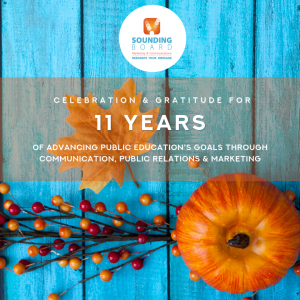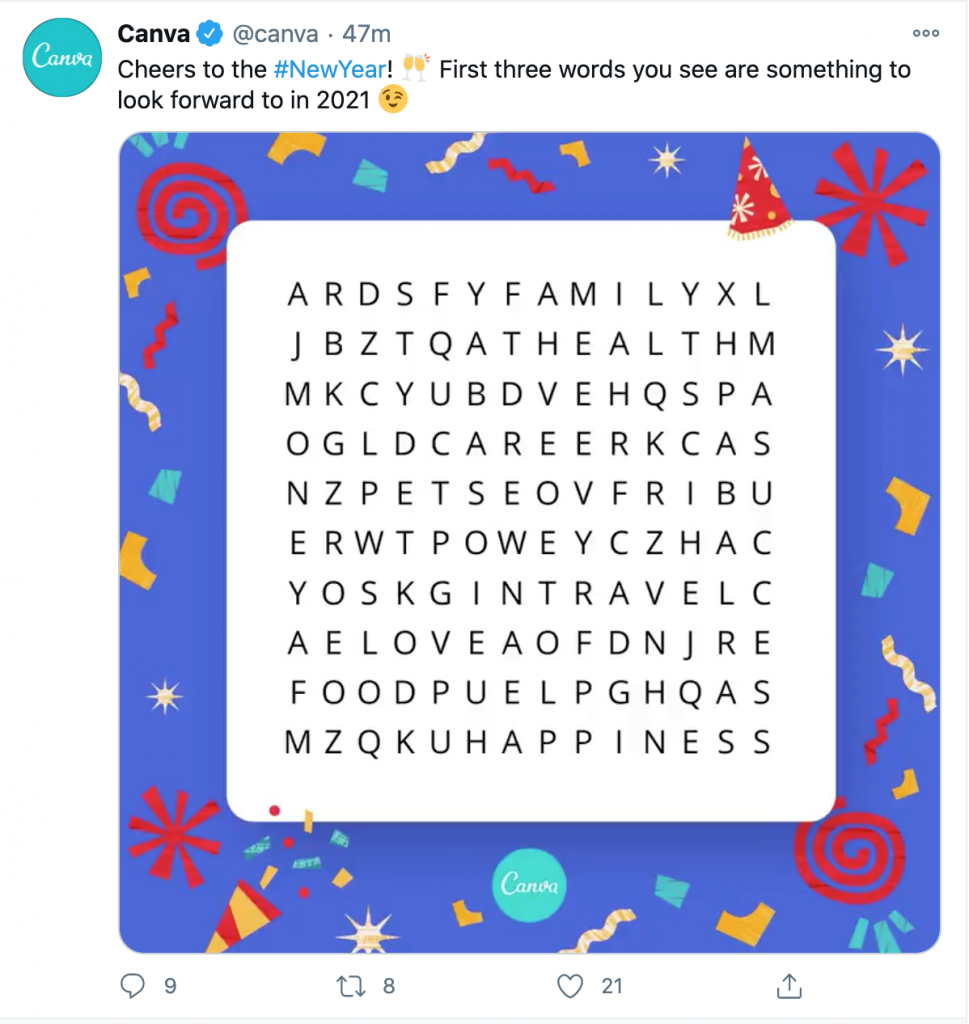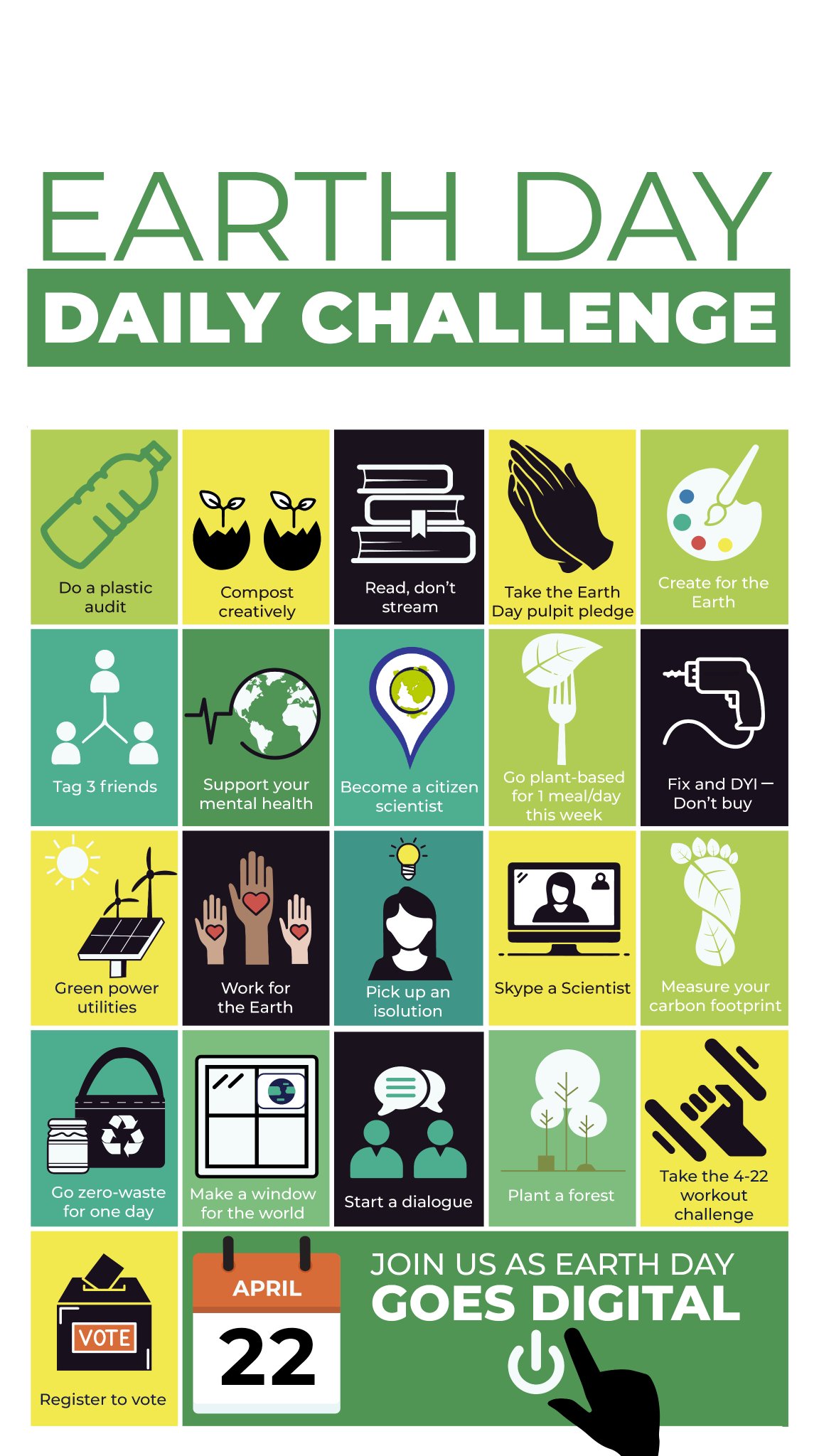- I’m grateful for my amazing clients–each one of them feels like family, and I am honored to be brought into the fold of their celebrations and challenges.
- I’m grateful for what my business has taught me–probably the most important thing has been authenticity: authenticity to myself, my clients and my work.
- I’m grateful to learn that my greatest challenges as a business owner and mother of three are also my greatest assets.
- I am grateful that I can advance my clients’ goals through communication, marketing, and public relations: whether it’s advancing equity in education, supporting a non-discriminatory environment, cultivating safer and healthier schools for students and staff, facilitating issues and crisis management, improving community engagement, promoting community and business partnerships, and beyond, I will continue to advance what is right, true and just in public education for my clients.
- I’m also grateful for my role as a cheerleader for the often-lonely-feeling role of our district administrators, especially, superintendents. Lifting up and coaching leaders is core to my work.
3 Ways to Improve Your District’s Homepage
Looking to revamp your district’s website for the upcoming school year?
As the school year comes to a close is your district looking to refresh your website for the next school year? Your website homepage is the most essential part of not only your website but your district’s online presence. The website homepage functions as a home base for not only your website and social media, but also for search engines. It is the

place where individuals come for resources and make judgments about the district as a whole.
It is important to have a clear and navigatable homepage. It is the place viewers go for information, the ho
me base to understand the values of the district, and the launching point to finding information and resources that they need. Are you looking to revamp your district’s website for the upcoming school year? Here are 3 ways to improve your district’s homepage.
1. Design that Aligns with the User Experience (known as UX)
 Putting the user at the center helps to guide homepage design. Putting the user and their navigation experience at the center of design decisions will help in determining the best layout and design practices. Overall user experience is taking the hand of the user walking them through the website making it clear where they need to go to fulfill their need or their goal.
Putting the user at the center helps to guide homepage design. Putting the user and their navigation experience at the center of design decisions will help in determining the best layout and design practices. Overall user experience is taking the hand of the user walking them through the website making it clear where they need to go to fulfill their need or their goal.
- Consider the user’s journey: The home page helps the user navigate to their next step. Are they trying to get a specific question answered? Can they use the homepage to navigate to the answer? Are they visiting the page for the first time and want to know more about the district? What overall impression does the homepage leave them with? Ensure that headers and topics are clear so that users can find what they are looking for. Ensure that–through content, media, and overall branding–a clear message and purpose are quickly conveyed so that someone new visiting your website knows exactly what your organization is about in the first second of entering.
- Navigation bar: The navigation bar helps maintain a clear and navigable hierarchy to your website. In seeking to not overwhelm the user, ensure that the navigation bar provides access to top-level subpages (this is “website speak” for the pages that you want them to click on) that can help give further direction and guidance.
- Uniform Colors: Use uniform colors to organize information and make the site understandable at a glance. Colors can help to organize different sections of a page and help to make sections of your homepage understandable and identifiable at a glance.
For more information and resources on website UX design, you can visit UX Studio Team’s blog website.
2. ADA Compliant Websites
In addition to creating a homepage that puts the user’s journey at the center of the design. It is essential to implement effective ADA-compliant standards to ensure that the design of the website and the homepage is accessible. Below are important design considerations to implement in your homepage for more comprehensive ADA guidelines you can use their toolkit and checklist for more details.
- Media Descriptions and Support: Include accompanying image alt tag descriptions and video transcripts. This allows media to be accessible to a broad audience. Providing image and media descriptions along with video transcripts allows for individuals to access and gain an understanding of a website when they use tools such as text to speech or text to braille.
- Consider Color Implementation: Avoid colors and texts that are dominating and compliant for color-sensitive users. Having defined fonts, and colors allow for users that have color or light sensitivity to adjust to reading and accessing information on the homepage.
3. Website Content Development
From media to copywriting, homepage content is what makes the user stay or leave in a matter of seconds. While information may be important to a district it may not be the content that should be on a homepage. The homepage serves a very specific purpose to be the door and the guide for the user to find the information that they need. It is the portal to enter rooms specific to their needs.
- Hot button topics: While it is important to address current issues and relevant information, its place often is not on the home page. It is important to not overwhelm the user with information on your home page and expect the user to know where to find that information. It is more important to guide users to get to the information they need. Consider using links or previews of headlines to help guide users to the hot button topics they want to learn more about.
- Using links to other web pages: Links are a powerful way on a website to help guide users without overwhelming information. Links and headers can be used to direct users to subpages on your district’s website in addition to useful outside sources as well. Links can be used to create connections with social media, maps, and other content-rich resources.
The homepage is central to your district’s website and is the key resource that guides and prompts the users towards the information that they need. A homepage that is navigatable and can be understood in the first few seconds of opening the page allows for first-time users to quickly understand your district, your brand, and an understanding of your culture. It can help to showcase up-to-date and timely designs that establish the relationship and trust with the user. Considering the design, experiences, and accessibility of your homepage is essential in creating a central and key resource.
If you are looking to reimagine your district’s website–from design (we have some great vendor partners), copywriting, or content–Sounding Board can help. Sounding Board offers resources that fit your district’s needs. You can discover services to help school districts navigate communicating strategically. To learn more about communication services that best fit the needs of your district you can explore Sounding Board Marketing & Communications Strategic Services. Schedule a 30-min consultation today and discover proactive communication to help fuel a positive and impactful transition to in-person learning.
Do Your Surveys Suck? 5 Tips For Creating Better Surveys
 Over the past seven months, school districts are using surveys more than ever to gather stakeholder preferences and feedback for their COVID-19 beginning of the school year planning and implementation of some form of in-person or hybrid reopening plans over the next few months.
Over the past seven months, school districts are using surveys more than ever to gather stakeholder preferences and feedback for their COVID-19 beginning of the school year planning and implementation of some form of in-person or hybrid reopening plans over the next few months.
While surveys are and can be a useful tool, a survey’s utility is only as beneficial as its design. In addition, survey results can have some intended consequences (providing the information being sought), and some very unintended ones, as well (stakeholders holding the results and positioning them as “votes” over the district’s head to pressure their leadership to take certain positions).
One of the biggest mistakes I am seeing right now is that school districts are using the term “survey” to define a number of things, from collecting information about learning preferences, feedback about distance learning, and more. The problem is, these are not all surveys. For example, I am seeing a number of “surveys” that are collecting information from parents about whether their child will be continuing to learn in a distance learning or will be transitioning to in-person (hybrid or otherwise) learning. These “surveys” collect student name, school, and contact information data, so that the districts know which students are returning to in person learning and which ones are remaining in distance learning. In reality, parents are not completing a survey–they are completing a registration form. Likewise, if you’re looking for the answer to one specific question, a poll might be a better choice, and if you’re looking for general feedback about your stakeholders’ overall experience with a program or approach to learning, asking for a review could be most effective.
Another mistake I am seeing is that surveys are asking for learning model preferences without providing all of the details to stakeholders. These questions fail to include all of the known information, and stakeholders may be opting for certain responses without understanding the impacts of those choices.
For example, a five day a week schedule in your district may mean that student cohorts will be split into morning and afternoon schedules, and will spend fewer hours in the classroom. Learning in person may mean that students will be required to remain with their cohort, will encounter restrictions during recess, will eat lunch in their classroom, and socialization will be greatly limited.
This is not to say that in person learning is filled with insurmountable challenges, but in parents’ excitement to return their children to school, they also may have certain assumptions of what that will look like, and similarly staff and teachers may also have certain assumptions as they complete their surveys.
Without painting a clear picture of what each survey choice means, stakeholders may be selecting certain options based on expectations and assumptions, and if those are not met, then your district risks creating confusion and disappointment, being accused of lacking transparency and losing trust in the process. This is why providing clear information to stakeholders in advance of sending surveys is so critically important–you don’t want to create more confusion when you send your surveys.
Maybe it’s been a decade since you took your research methods class in grad school–or maybe you never took a course at all. In any case, anytime you want to create a survey, you need to be thoughtful and thorough. So, here are five ways to improve your surveys so that your stakeholders feel valued, you will collect the data you need, and you’ll prevent confusion and unintended consequences.
5 Ways to Improve Your Surveys
- Be prepared. First, establish your survey’s goals and objectives. What information do you want to gather–preferences, taking the temperature of your stakeholders, obtaining registrations? How do you want to use this information? Would your survey be best suited to be split up into two surveys? If you have vastly different goals, you may want to consider sending two different surveys so that you aren’t confusing your stakeholders. Lastly, determine whether a survey is the best approach for gathering the information you are seeking, or if focus groups or an advisory committee would be more effective.
- Be informative. Provide clear information in advance of sending your survey–on your website, through video, and through stakeholder meetings. Your survey should not be the first (or only) place where information is conveyed. Make sure you are preparing your stakeholders with the most up to date information before asking them to take a survey, otherwise your survey results will not be accurate, and your stakeholders will accuse your district of lacking transparency.
- Be clear. Are you collecting information, do you want people’s commitments, are you taking a poll or wanting a review? A survey collects data. Registrations collect commitments. Polls collect preferences, and reviews collect feedback. So, be clear with your audience about how you will be using the information you are collecting, and clearly and accurately title the survey. Additionally, avoid jargon, keep questions clear and concise, and don’t ask loaded questions.
- Be thoughtful. Based on your survey goals and objectives, develop easy to understand, bias-free survey questions. Make sure that you are not asking leading questions. Do a test run with friends and family outside of your organization to catch any problems or issues with your questions or survey design.
- Be varied. Provide a balance of different types of survey questions being asked, and based on the goals and objectives of your survey, you approach to survey questions should support those goals and objectives. Hubspot provides a great summary of the different types of survey questions, and how to use them, but here is their easy-to-understand summary of the question types in case you needed a refresher:
- Multiple Choice: Multiple choice survey questions are questions that offer respondents a variety of different responses to choose from.
- Rating Scale: Rating scale questions (also known as ordinal questions) ask respondents to rate something on a numerical scale assigned to sentiment.
- Likert Scale: Likert scale survey questions evaluate if a respondent agrees or disagrees with a question.
- Ranking: Ranking survey questions ask respondents to rank a variety of different answer options in terms of relative priority or importance to them.
- Semantic Differential: Semantic differential survey questions also ask for respondents to rate something on a scale, but each end of the scale is a different, opposing statement. Use semantic differential questions to get clear-cut qualitative feedback from your stakeholders.
- Dichotomous: Dichotomous survey questions offer only two responses that respondents must choose between.
- Close-Ended: Close ended survey questions are questions that have a set number of answers that respondents must choose from.
- Open-Ended: Where the survey types above all have closed-ended answers that you input as different options to choose from, open-ended questions are usually accompanied by an empty text box, where the respondent can write a customer answer to the question.
The bottom line: Sending a survey is a lot like Thanksgiving dinner. You’re gathering the family around the table and feeding them the opportunity to share their thoughts. Remember to set your table with care before feeding your family. Your stakeholders will thank you for it.
5 Things To Update on Your District and School Websites-Today
 It’s September 28, 2020, and for many of you, your schools have been in session for about a month now. Although it feels like it’s been a lifetime, it has been only 4-6 weeks. During this time of constantly shifting priorities, it’s easy to lose site of cleaning the proverbial cobwebs that might be growing on your website pages.
It’s September 28, 2020, and for many of you, your schools have been in session for about a month now. Although it feels like it’s been a lifetime, it has been only 4-6 weeks. During this time of constantly shifting priorities, it’s easy to lose site of cleaning the proverbial cobwebs that might be growing on your website pages.
Have you updated and cleaned up your website content lately? I’m not talking about the millionth-plus-one “Update” that you posted on Friday in response to a recent board or MOU decision…I’m talking about the rest of the stuff you posted since the crazy, ever-changing weeks before the first week of school, and everything since.
I’m currently working through updating a client’s website content on their school reopening and distance learning pages, and as great and informative as that content was before school began, there have been some changes, there is information that is not as useful now, and I want to make sure that their audiences know that those pages are continually updated, especially as the district prepares for potentially opening their school buildings to hybrid learning in three months.
In the hustle and bustle of long board meetings, shifting requirements and policies, and trying to stay on top of the great news that is happening in your district, it’s possible that these updates have slid off your priority list. But, for a parent who is wading through the masses of information on your website, more information isn’t necessarily better, especially if it’s outdated. And, if a parent needs to wade through a page of a half a dozen or more date-stamped updates going back three months, it’s really time to streamline your web content.
So, here are 5 things to update on your district and school websites–today:
- Change all future tense verbs to present tense. Is your content geared for a parent/staff audience anticipating information about the upcoming school year? A month in, the school year is off the ground, and no one is anticipating last month’s information. For example: “the 2020-21 school year, which begins on August 19th” should be changed to “which began on August 19th.”
- Archive any updates that occurred prior to this week. If you don’t already have a “Process” page as part of your school reopening information web pages, I strongly suggest creating one, which can include a timeline of important decisions that have been made (and ones scheduled in the future) with links to relevant documents and announcements.
- Clarify which decisions/plans still stand, despite changes to county/state criteria. The state of California has had a couple of shifts to its criteria for loosening restrictions, as elementary school waivers, and if your MOUs and/or board decisions differ from these at all, then it’s important to clarify the district’s plans and timelines.
- Update timelines: Are the timelines current? Are they clearly communicated? Don’t expect that timelines verbally expressed during a board meeting or nestled into a presentation or a report will be read or known by your stakeholders. Clearly communicate important timelines, and even if timelines are tentative, this information also needs to be conveyed in a transparent manner.
- Review website categories, page headers, subheads and links. Are your pages still organized in a way that prioritizes the preparation activities for the school year? Now that information needs have shifted, be sure to rename your website categories, links, headers and subheads accordingly, and ensure that the highest priority information is listed first, and if new pages need to be created for specific categories (especially if certain pieces of information should be housed on its own page, like wellness resources, academic assistance, etc. Also double check that links to pages are updated.
Through updating and streamlining your website content, you will keep your audience engaged, continue to communicate in one clear and consistently messaged voice, and reinforce transparency.
We’re here to help
If you’re balancing school/district leadership with communication responsibilities, and you’re finding yourself falling behind on timely and consistent communications across your communication channels, Sounding Board Marketing & Communications can help. Contact us for a free 30 minute consultation, or sign up for any of our services.
What are some other topics that you are keeping updated on your websites?
Leave your reply below in the comments!
Running Your Communication Offense & Defense
 The best PR tip I can offer in the midst of COVID-19 (or any crisis, for that matter) is that you should be running an offense and defense at the same time.
The best PR tip I can offer in the midst of COVID-19 (or any crisis, for that matter) is that you should be running an offense and defense at the same time.
This can be a challenge to do, if you’re a one person PR team (or administrator wearing multiple hats, including PR). So, if you haven’t already put together a communication and PR team, start now.
However, it is incredibly important to not only manage the current reality, but also to paint a picture of the future.
I read a great recent article on PR Daily that I’m going to summarize here, and put into context for education organizations, particularly during COVID-19 school closures and re-openings.
Your Defense Team
Your “defense team” includes those managing the current crisis. This team should be comprised of the most resilient—those who are quick to take action, are the voice of calm and reason, and who survey the current landscape and adhere to the facts as they manage the crisis.
In a school district your defense team should include someone from HR (familiar or involved with current negotiations), an instructional administrator (like an Assistant Superintendent for Instruction/Curriculum), and a student welfare/social emotional health administrator.
Your Offensive Team
Your offensive team looks to the future and is not involved in the current crisis. Those best suited for this team are curious and self-starters—they veer away from comfort zones, are competitive and strategic, and can see at least six months down the road. This could be your CBO, facilities director, health officer/administrator, and a principal rep for each level in your district (elementary, middle, high school).
You, as the communication leader, will work with both teams and manage the strategic direction and progress, and your superintendent will also be involved with working with both teams, as they set the direction for the district as a whole.
Both teams should be providing talking points to your Board of Education and coaching your board members on resisting the urge to post articles or opinions that may cause confusion about the district’s messaging or plans.
Keeping an Eye on Your Future
While your stakeholders are living in the present, they are also shaping their opinions about the future. While yes, parents are focused on what grading options are available and how Class of 2020 graduates will be honored during shelter in place, they are also creating some very strong opinions about distance education–not just the delivery, but also the quality. Parents and staff members are also concerned about schedules and safety when schools re-open.
- Communicate about your district’s commitment to providing a high quality educational experience and your district’s values: Parents have choices, and there are many online education programs that may be delivering distance education in a higher quality format and approach than what is being offered by their school district. With the prospect of distance education being some part of a hybrid educational approach in the 2020-21 school year, it is imperative that you are reinforcing parents’ confidence in your schools by letting them know how you are planning on ensuring that students are receiving a high quality education and what that will look like in 2020-21.
- Communicate about what discussions are in progress about the upcoming school year: Silence is not golden in the world of communications. Silence opens up too many opportunities for other people to fill in the blanks. Provide your stakeholders some information about the conversations you’re currently having about next year’s re-opening plans, what assumptions will be made, and your district’s priority on the health and safety of students and staff.
- Show empathy: Acknowledge that you understand that parents and staff desire to have concrete answers so that they can plan ahead, and show gratitude for their patience. Let them know that the upcoming school year will be different for everyone, and that the district is planning for providing more emotional/social supports for students and staff in navigating the changes ahead.
Every great team has a strong offense and defense running parallel, and in school districts, you can develop two strong communication teams that can effectively manage the current needs while also keeping an eye on the ball, so that you can have a winning approach to keeping your district’s reputation and relationships strong and intact.
Need help developing your winning team?
As an integrated partner and strategic advisor, Sounding Board Marketing & Communications can come alongside you in developing your communication team and providing strategic advising to implement successful communication approaches. Give us a call at 916.673.8868 or hvmcgowan@sounding-board.net
Before you Send That Email, Tweet, Record That Message…
 Crises are incredible opportunities to use communication to strengthen relationships with stakeholders. In the midst of COVID-19 and the drastic changes to the educational landscape, I’ve been watching my fellow California School Public Relations Association and National School Public Relations colleagues rise to the challenge to inform parents, staff and the public about school closures, free meals, distance learning, mental health tips and resources, community resources, and ways that their staff are going above and beyond the call of duty. And, in some cases, superintendents and support staff are being thrown into implementing crisis and ongoing communications tactics in ways they never have before.
Crises are incredible opportunities to use communication to strengthen relationships with stakeholders. In the midst of COVID-19 and the drastic changes to the educational landscape, I’ve been watching my fellow California School Public Relations Association and National School Public Relations colleagues rise to the challenge to inform parents, staff and the public about school closures, free meals, distance learning, mental health tips and resources, community resources, and ways that their staff are going above and beyond the call of duty. And, in some cases, superintendents and support staff are being thrown into implementing crisis and ongoing communications tactics in ways they never have before.
They’re also competing with an onslaught of communications from businesses and other organizations that are also communicating what they are doing to keep customers safe, business and product delivery options, and well-meaning free approaches to keep children, teens and adults entertained, in good health and more.
It’s enough to saturate any audience member. This also creates the real and huge risk of audience members tuning and checking out, scanning information quickly, and missing the important details.
Now, more than ever, it’s imperative for communicators to lead their organizations in strategic communication planning and implementation. This process is a cycle of the four step PR process: Research, Planning, Implementation, Evaluation.
More communication is not better. More tactics won’t help you reach your audience members. Targeted, strategic, well-messaged communications and tactics are what will allow you to be effective in reaching your audiences, and continue to increase and retain audience trust, and ensure your audience members are doing what you want them to do.
Because I will assume that you have already implemented your communications tactics, we’re going to begin with Evaluation, which is the fourth step in the 4-Step PR process. Typically, you’ll start with Research.
Step 1: Evaluation
I know it seems odd to start with the final step of the 4-Step PR process, but as I previously mentioned, this is a cycle. Most likely, you’ve already implemented the first three steps, but you probably haven’t had an opportunity to come up for air and evaluate. Evaluation is answering the questions “How have we been successful?” “How can we do better?” and “What do we need to adjust moving forward?”
Here are a couple of examples of what to evaluate:
- Environmental Scan: Evaluate where your organization is in this crisis. Most likely, your schools have been closed for at least one week, and distance learning plans are in place, and possibly implemented. Ask yourself whether daily (or twice daily) communications are still necessary, or if you can reduce communications to 2-3 days per week.
- Engagement, Click Throughs/Opens, Phone Message Logs: Review your social media engagement, email click throughs and open rates, and phone message logs. What patterns do you see? Are you seeing a dip in email open rates and click throughs later in the week? What questions are being asked on social media? Are your videos being viewed? What kinds of comments are being made? Take note of what seems to be engaging people the most, what questions need to be answered in FAQs, and other data that will help inform your future communications. Also, anecdotal feedback from audience members can be incredibly valuable.
Step 2: Research
Research essentially defines the problem. From the evaluation process, what problems have you uncovered?
- Who do you want to REACH? Are you reaching your audiences effectively, or are there holes?
- What do you want them to DO? Are your audiences acting/reacting in the intended ways from your previous communications, or do you need to provide clarification and/or other communication avenues (i.e. Setting up separate Facebook or Twitter profiles for answering IT questions from parents, staff)
- What messages do you want to communicate to each public that will encourage desired behavior, increase knowledge and change attitudes? Review your previous messages—are they working, do they need to be tweaked?
Step 3: Planning
The Universal Accreditation Board outlines a 10-step PR plan (which I also use with my clients) that will work for any situation.
- Goals: This is a state of being that you want to accomplish through your communications. Example: “For every audience ABC School District audience member to clearly understand what they should be doing during COVID-19 school closures and how the District will support and serve as a resource for families and employees.”
- Target Audiences or Publics:
- Who needs to know or understand?
- Whose advice or support do we need?
- Who will be affected?
- Objectives for Those Audiences:
- Objectives are shorter term.
- Define what behavior, attitude or opinion you want to achieve from specific audiences, how much to achieve and when.
- Think in terms of the awareness, attitude or action you desire – the end result.
- Strategies
- The road map or approach to reach objectives.
- Do not indicate specific actions.
- Use verbs such as demonstrate, collaborate, etc.
- Tactics: These are the specific activities conducted to implement strategies of a program.
- How you will use your resources to carry out your strategy and work toward your objectives.
- Examples: Meetings, publications, news releases, websites, billboards.
- Activities: Specific activities required under your tactics to carry out strategies.
- Informal plans often jump from objectives to activities.
- Vehicles or channels you will use to communicate are listed here.
- Evaluation
- How will you know if you are reaching your objectives?
- Measurement? Observation? Opinion? Feedback?
- Materials: What do you need to implement/execute your tactics?
- Budget: Out-of-pocket costs, staff time, volunteer energy, transportation, images, materials, fabrication, etc.
- Timetable and Task List
- What does what and when?
- Work backward from deadline or forward from start date
STEP 4: Implementation
Implementation involves actual messages sent through the communication channels and tools you will be using, and includes monitoring tools for execution. And then, once you have implemented your plan, then you will come back to evaluation.
Remember, this is a process and a cycle. But it is effective, and it works.
If you haven’t implemented this approach previously, it will likely feel cumbersome to go through these steps, particularly if you are already feeling overwhelmed. However, this will become like second nature once you’ve gone through the process. You will likely uncover ways to be more efficient and effective in your work, as well.
Have questions? Need clarification?
I’m always happy to hop onto a call to help answer questions and guide you through the steps. Feel free to contact me at 916.673.8868 or hvmcgowan@sounding-board.net. We’re in this together and we’ll get through this together.









